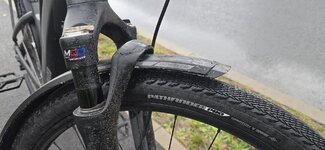Jeremy McCreary
Bought it anyway
- Region
- USA
- City
- Carlsbad, CA
I've had my SL all of 4 weeks, and it's had tubeless Pathfinder Pros all of 3 weeks. Not much of a track record yet, but I'm already a big fan of these tires.The tyre size is not everything. Vado SL 5.0 has the Future Shock suspension stem, which reportedly does miracles to the ride comfort. @Jeremy McCreary rides his 5.0 SL tubeless on Pathfinders Pro 38 mm, and he could certainly chime in.
Compared to the stock Nimbus 2 city tires, huge improvent in ride comfort, excellent grip offroad, and noticeably lower rolling resistance on pavement — all this at 38 mm and 36 psi. No need for a suspension seat post now. Remarkably, they even did well in a brief trial on damp low-tide beach sand!
Same here in mostly dry coastal SoCal. There's a sandy veneer of variable depth on every unpaved surface — usually just a millimeter or less, but it's usually loose, and deeper pockets appear without warning. Makes steep sections pretty scary, sometimes even on foot.View attachment 183697
Poland is a sandy country. Even a decent gravel road gets sandy during drougt.
So far, the Pathfinders are doing fine on the thin coatings.
During wind events, any beach-adjacent pavement gets blowing sand. Above is the Coast Highway at South Ponto Beach as a big winter storm blew in off the Pacific. The rain came later. The hub-drive's 2.3" hybrid tires had no trouble riding through here, but my poor eyes and nose were full of sand.
Last edited:

